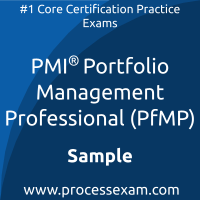 You have to pass the PfMP exam to receive the certification from PMI. To increase the effectiveness of your study and make you familiar with the actual exam pattern, we have prepared this PMI Portfolio Management sample questions. Our Sample PMI Portfolio Management Professional Practice Exam will give you more insight about both the type and the difficulty level of the questions on the PMI Portfolio Management exam.
You have to pass the PfMP exam to receive the certification from PMI. To increase the effectiveness of your study and make you familiar with the actual exam pattern, we have prepared this PMI Portfolio Management sample questions. Our Sample PMI Portfolio Management Professional Practice Exam will give you more insight about both the type and the difficulty level of the questions on the PMI Portfolio Management exam.
However, we are strongly recommending practice with our Premium PMI Portfolio Management Professional (PfMP) Practice Exam to achieve the best score in your actual PMI PfMP Exam. The premium practice exam questions are more comprehensive, exam oriented, scenario-based and exact match of PMI Portfolio Management Professional exam questions.
PMI Portfolio Management Sample Questions:
01. Working to prepare the communications plan, a best practice to follow is to use the roadmap. By doing so, it:
a) Shows the overall portfolio timeline, useful for determining the frequency of reporting
b) Provides information about interdependencies that may affect objectives
c) Emphasizes milestones and the timing of key benefits
d) Shows applicable constraints
02. The portfolio management process ensures the components are aligned to goals. However, it is driven by:
a) Viability
b) Value and benefits
c) Organizational strategy and objectives
d) Interdependencies and resource constraints
03. An example of a simple prioritization model is one in which the criteria are:
a) Easily quantifiable
b) Both qualitative and quantitative
c) Focused on benefits realization and sustainment
d) Focused on both short- and long- term goals
04. The roadmap forms the initial basis to establish dependencies, which are:
a) Part of each component
b) Within the portfolio and between organizational areas
c) Especially important for standalone projects to show why they are being pursued
d) The basis for prioritization mapping
05. It is a best practice for the portfolio manager as he or she prepares the portfolio strategic plan to:
a) Involve stakeholders at all levels in the process
b) Communicate its importance throughout the organization
c) Integrate and respond to changes in the portfolio
d) Ensure funds are available to allocate to each category in the portfolio
06. While there are a number of recommended contents of the portfolio strategic plan, a guiding principle is to:
a) Document assumptions and constraints
b) Recognize stakeholder risk tolerances
c) Recognize the portfolio will evolve through progressive elaboration
d) Define the portfolio vision and objectives to align with organizational strategy
07. One key artifact to review as the portfolio communications management plan is prepared is the:
a) Portfolio management plan as it shows all elements in it have communications requirements
b) Portfolio performance plan as it sets forth needed reports and their frequency
c) Portfolio strategic plan since it shows the need for strategic alignmen
d) Portfolio beneits realization plan to determine reports on progress in benefit realization, transition, and sustainment
08. Capability and capacity analysis are two techniques that complement one another to help determine the portfolio structure as there may be limiting factors for the number of components an organization can execute. These limiting factors include:
a) Capability factors such as resource availability
b) Capability factors such as lack of key skill sets
c) Capacity factors such as financial and asset considerations
d) Capability factors such as financial and asset considerations
09. A useful guideline to identify the portfolio and sub-portfolios is the:
a) Portfolio charter
b) Portfolio performance plan
c) Portfolio structure
d) Roadmap
10. In identifying risks to then manage and control, as the portfolio manager you are consulting organizational process assets such as:
a) Commercial data bases
b) Lessons learned
c) Knowledge bases
d) Values
Answers:
Question: 01
Answer: b |
Question: 02
Answer: c |
Question: 03
Answer: a |
Question: 04
Answer: b |
Question: 05
Answer: c |
Question: 06
Answer: d |
Question: 07
Answer: a |
Question: 08
Answer: d |
Question: 09
Answer: c |
Question: 10
Answer: d |
If you find any errors or typos in PMI Portfolio Management Professional (PfMP) sample question-answers, please report them to us on feedback@processexam.com
 You have to pass the PfMP exam to receive the certification from PMI. To increase the effectiveness of your study and make you familiar with the actual exam pattern, we have prepared this PMI Portfolio Management sample questions. Our Sample PMI Portfolio Management Professional Practice Exam will give you more insight about both the type and the difficulty level of the questions on the PMI Portfolio Management exam.
You have to pass the PfMP exam to receive the certification from PMI. To increase the effectiveness of your study and make you familiar with the actual exam pattern, we have prepared this PMI Portfolio Management sample questions. Our Sample PMI Portfolio Management Professional Practice Exam will give you more insight about both the type and the difficulty level of the questions on the PMI Portfolio Management exam.